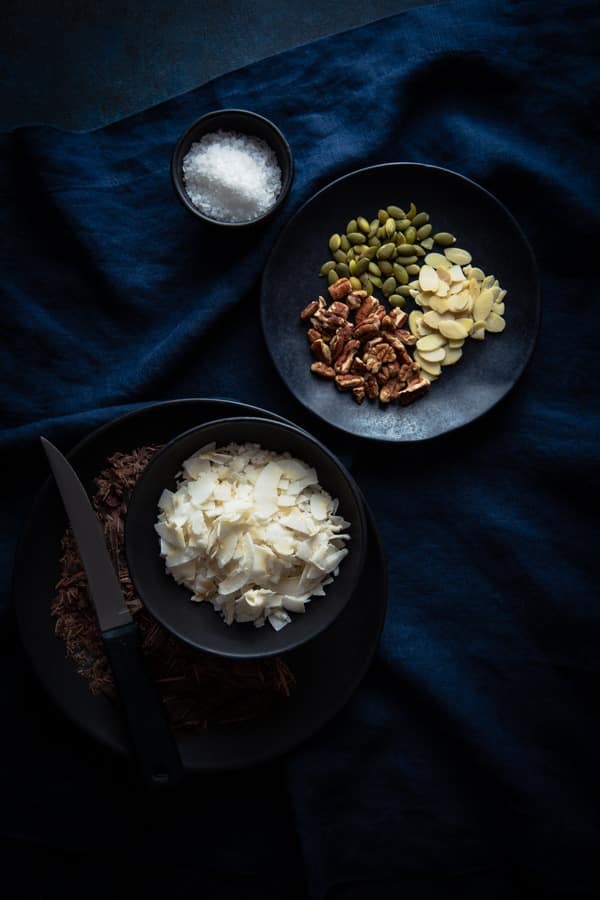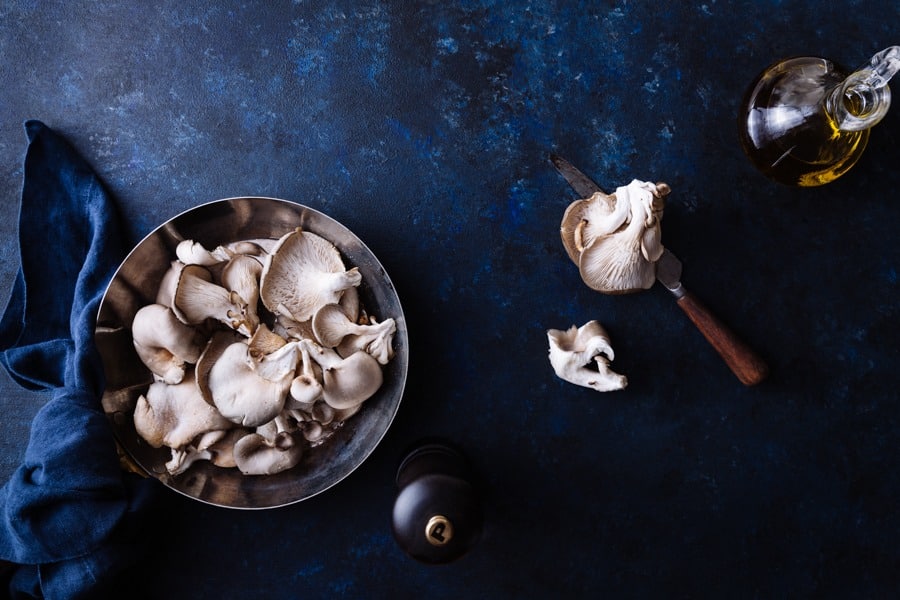
Thanks to Instagram, overhead shots of food have become incredibly popular. This graphic style is great for flattening depth and getting more elements into a frame.
Smartphones have very wide lenses, which means that food shot at a three-quarter angle usually looks like it’s sliding off the table. Shots taken at eye level or from above work best. This trend has translated into the editorial space, and you now see it everywhere–including the top foodie magazines.
Here are my top tips for stunning flatlays.

Use a Tripod with an Extension Arm
A tripod is a must in food photography. It frees up your hands to style to the camera and keeps your camera steady so you can get sharp photos. This is doubly important if you’re shooting in natural light. You’ll be able to go low in your shutter speed when you don’t have enough light, which can be common in the winter months.
To shoot stunning flatlay photography, you’ll need a tripod with an extension arm, or a separate extension arm that you can attach to it. This will allow you to keep your framing consistent, and to use your hands to style your scene without constantly having to put down and pick up the camera. It will ensure that your images are straight, and most importantly, you won’t kill your back in the process.
Note that when you use an extension arm, that you’ll need to add a counterweight like a sandbag to keep everything steady, otherwise the weight of your camera and lens can make your whole tripod topple over.
If you have the budget for it, a triaut tripod like this one will allow you to get really high (like over a table). A good triaut will offer a centrepost to orientate overhead.
Use a Subtly Textured Backdrop
Your choices of backdrops and surfaces are very important in food photography. Food can inherently have a lot of texture, so a highly textured background can be distracting and compete with your subject.
When you shoot overhead, the texture will be more visible. The best approach is to choose a backdrop with a bit of texture, but not too much. Backdrops that are mottled and consisting of 2-4 similar colours are very popular. You can buy them from a backdrop store or paint your own.
To get ideas on DIY food photography backdrops, check out this post.

Try Backlighting
Backlighting is such a great choice in lighting style for food photography because it brings out texture and liquid properties of food. This is why you see cocktails and soups often shot this way. I use backlighting for stunning flatlay photography most of the time.
The problem with backlighting is that you can end up with the top of your image blown out, while the bottom is underexposed. You can remedy this by playing with the distance of your light to your set, and bouncing the light back into the scene with a reflector or piece of white foamcore.

Create Flow with Your Compositions
Composition is a huge topic with many guiding principles. These are the same principles that artists have used for centuries. In food photography, how we place our main subject and the supporting elements within the frame is crucial for creating tension and flow. The goal is to keep the eye moving through the image, rather than exiting it. This happens very quickly and at an unconscious level.
One of the best ways of creating flow is to compose your elements in a variation of an S-curve. It can be very subtle, but it will do the trick to keep your viewer interested in what’s going on in the image.
A bit of tension can also keep the eye from moving out of the frame too quickly, so cutting off a supporting element and not shooting too loosely will have a big impact.

Watch for Proportion and Scale
One thing that can make propping flatlays difficult is that some props can look huge to to the camera when it’s positioned overhead. Even a pinch bowl can look humongous positioned to soup bowl because the the bird’s-eye angle flattens depth.
Pay attention to the size of your dishes and other props and make sure there is some variety in terms of size. Proportions and scale are important in making the elements in your image look realistic.
In the image below, I made sure my props were all different sizes but that that difference wasn’t a big one. The dishes were all quite small, with the largest plate being a salad one. I also chose a knife that wasn’t too large in proportion to the other props.

Play with Fabrics
Fabrics are my favourite prop when it comes to shooting flatlays. I love to use them as backdrops or to partially cover another backdrop to create a subtle layer and juxtaposition of two textures. Fabrics are easy to transport and don’t take up a lot of space, unlike some photography backdrops.
Linen is my fabric of choice, but I also like to use damask, canvas, or fabrics with a subtle pattern. Linen is easy to drape, looks good when it’s wrinkled, and gives you less colour shifting than you often get when photographing other fabrics.
I like to buy individual linen napkins at places like Crate & Barrel. It can also be worthwhile to buy a large piece of linen from the fabric store and dye pieces with fabric dye using buckets.

Tell A Story
Storytelling is an important concept in food photography.
In food photography, the aim is to stir the sense and emotions. You have to make the viewer want to eat your subject. Even the simplest food photos often give the feeling of a wider story going on than what is seen in the frame.
The story can be as complex as an elaborate tablescape, or a more simple scene showing food preparation. Lately, introducing a lifestyle element with hands has been very popular in food photography, and can work really well in flatlay photography.
Before picking up your camera, ask yourself what you want to convey. Consider your subject and what would be the best way to highlight its most attractive properties. A pile of raw mushrooms may not seem very interesting, but put them in a pan, add some seasonings, olive oil, and the sense that they are being prepared for a delicious meal can make a simple ingredient look more captivating.

Conclusion
Creating stunning flatlay photography can be easy with a few simple tips. One of the reasons that it has become so popular is because they can be easier to compose and allow for several elements to fit nicely in the frame.
If you’re interested in learning more about composition, check out my eBook Rule-of-Thirds: A Guide to Composition for Food Photography. The book not only goes over the compositional principles in depth with examples, it contains 42 templates you can copy or use as prompts to inspire your own creativity.



